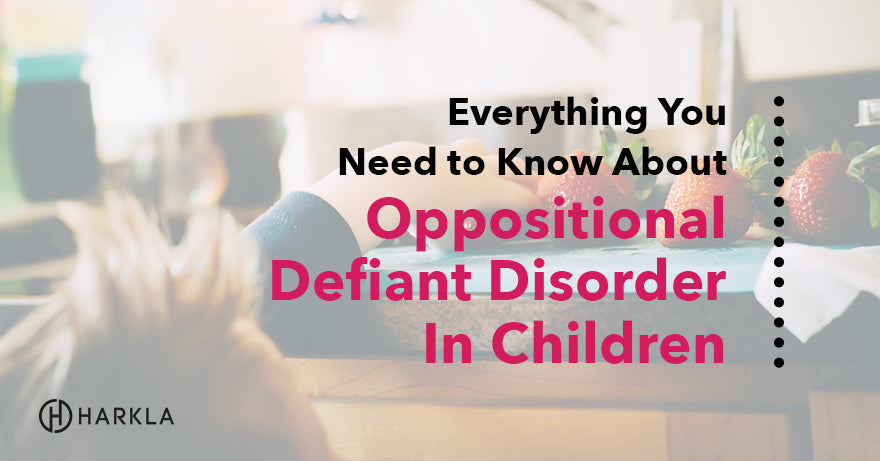Your Cart is Empty

Oppositional defiant disorder (ODD) is a diagnosis that is becoming increasingly more frequent, however, it is oftentimes a misunderstood diagnosis. There has been a long history of labeling children with ODD as “troublemakers” or as “difficult” to treat and parent.
This is likely because the behaviors associated with this diagnosis can be difficult to address if education is not provided on the most effective approaches. In this article, we will look at the characteristics of ODD, explore some of the potential causes, and highlight the best ways to treat ODD and address the behaviors associated with ODD.
Traditionally, ODD is defined as a set of behaviors that includes defiance and disobedience towards authority figures. Most children and teenagers will go through periods of defiance or disobeying rules, however, it is important to note that children with an ODD diagnosis will have a continued pattern of these types of behaviors that span years. They also present as frequently angry, irritable, defensive, argumentative, and may even be vindictive towards parents or other authority figures.

For the majority of children with ODD, this pattern of behavior can be traced back to preschool age, which is when symptoms often first emerge. For other children, it appears in the early elementary years, but no later than the age of 12. Again, most children will go through periods of defiance, however, the behaviors seen in children with ODD will be more extreme and will have a direct impact on their functioning at home, school, and in the community.
The Diagnostic and Statistical Manual (DSM-5) is the go-to resource for diagnosing mental health disorders in children and adults. An ODD diagnosis must be given by a trained professional, typically a psychologist or psychiatrist. Let’s review the DSM-5 criteria for ODD in children.
Firstly, the symptoms must last at least six months and include:
The DSM-5 also classifies ODD by severity. The three types of severity are:
There is no known, direct cause of ODD in children. Researchers believe that a combination of genetics and environmental factors likely contribute to the development of ODD. For example, a child’s genetic makeup or temperament may make them more susceptible to developing ODD, and combined with factors such as lack of supervision at home or inconsistent discipline, ODD may develop.
There are additional risk factors that may make a child more susceptible to developing ODD in childhood. These are reviewed below.
Overall, children with ODD often have difficulty across settings, including at home with parents and siblings, in school with teachers and authority figures, and at work with their bosses. In addition, they are likely to have frequent conflicts with peers and find it difficult to make and maintain peer relationships.
ODD is often a co-occurring disorder, meaning that the child likely has another mental health diagnosis. The most common co-occurring disorders include attention-deficit/hyperactivity disorder (ADHD), Depression, Anxiety, learning disorders, and Conduct Disorder.
Now that we’ve reviewed the behaviors associated with ODD and the potential causes and risk factors, let’s consider the most effective ways to address the behaviors found in children with ODD.
As with any disorder, early intervention is important whenever possible. In the case of ODD, intervening early is the most effective way to ensure a more positive outcome. Early treatment of ODD can help manage behaviors before they worsen and gives parents and other authority figures an opportunity to work on developing a positive relationship with the child, which is a huge protective factor.
Consistency in parenting and behavior management is also extremely important in managing ODD. If a child is receiving mixed messages from parents or other authority, the oppositional pattern is likely to continue. Therefore, it is essential that parents are on the same page when it comes to addressing behaviors, discipline, and consequences.
Setting reasonable, age-appropriate expectations for behavior is also important. For example, it is expected that a middle school-aged child could participate in daily household tasks, such as picking up after themselves, helping with chores like taking out the garbage and maintaining the upkeep of their bedroom. Oppositional behaviors are more likely to appear when the demands placed on the child are above their age or maturity level or are unreasonable.
Avoid power struggles when possible. Oftentimes, children with ODD may nitpick or look for ways to start arguments or disagreements. By being consistent, firm, and not going back and forth with the child, you are setting clear expectations, which is the best way to help manage ODD.
Foster the child’s self-esteem by encouraging activities that are positive or that the child is successful with. It is always important to consider the child’s strengths, even when behaviors are difficult to manage. For example, a child with ODD may enjoy playing a certain sport. It is important to encourage this pro-social behavior and link this to the child’s view of himself.
In most instances, parents of a child with ODD will seek out treatment options to help manage their child’s behaviors.
These treatments are provided by a qualified mental health provider, such as a counselor, therapist, or psychologist. Below we will review some of the most common treatment approaches for children with ODD.
This is the most common and most effective intervention for addressing ODD in children. A mental health provider can assist parents in developing parenting techniques that stress consistency in managing the child’s behaviors. In some cases, the child may be involved in this type of treatment as a way to bring everyone together to develop clear goals.
Generally, most children with ODD will also benefit from individual therapy. The focus of therapy will likely be to help the child develop more positive coping skills, find ways to better manage stress and frustration, and work on finding ways to better express their feelings.
CBT is another common approach to addressing ODD. In this type of treatment, the therapist will work with the child to help them change their thought patterns and help them recognize how this is related to their behavior problems. For example, many children with ODD have automatic negative thoughts. So, in any given situation, their first thought is a negative one. Helping the child recognize how this could be influencing their behaviors is the goal of CBT.
Most children with ODD struggle with peer relationships and understanding the viewpoints of others. Social skills training can be an effective way to help them practice these skills and become more flexible in their peer relationships.
While autism and ODD are different, social skills training can be similar. You can read more about our autism social skill recommendations here.
There are currently no medications used to solely address the behaviors of ODD and generally speaking, behavioral approaches and therapy are typically the first lines of intervention for ODD.
In some instances, medication may be used to target certain symptoms of ODD, especially if there is a co-occurring disorder. For example, some children with both ODD and ADHD will be prescribed a stimulant to help manage impulsivity, which is a common characteristic of both disorders.

Parenting a child with ODD can at times feel exhausting. Many parents identify feeling powerless in their relationship with their child. A support group can help connect parents who are raising children with ODD and other mental health disorders. These groups offer support, feedback, and are often a helpful place to discover new, effective parenting strategies. A great place to start looking for support is online. Facebook offers many support groups for parents of children with ODD.
It is important to note that the treatments described above are typically provided on an outpatient basis when behaviors are still at least somewhat manageable. If a child’s behaviors become too difficult to manage in the home or community setting or if the child’s behaviors pose a danger to himself or others, other treatment options, such as residential placement, may need to be considered.
Overall, it is important to recognize that children with ODD will exhibit behaviors that can be challenging for parents and other authority figures to address. However, with effective treatment, community supports, and the use of certain behavioral strategies, these behaviors can be manageable.
Most importantly, it is helpful to recognize that all forms of behavior are a way of communication. When a child is exhibiting defiant behavior, often the first reaction is to discipline or engage in actions that may actually continue to promote the behavior.
By using the strategies and treatment options discussed in this article, the outcomes and prognosis of ODD in children are much more promising.
References
Rowe, R., Maughan, B., Costello, E., & Angold, A. (2005). Defining oppositional defiant disorder. Journal of Child Psychology and Psychiatry, 46(12), 1300-1316.
Comments will be approved before showing up.


Dawn Brents
January 30, 2023
Our son, adopted at age 4 from foster care, had the diagnosis of RAD, SPD, anxiety, ADHD and ODD until he was 9 years old and had a second barrage of neuropsychological testing done. That psychologist took away ODD and encephalopathy to his chart because she said ODD sets him on a punitive course. She said the behavior is the same but it helps parents under that it is a brain issue. The child is not trying to be defiant even though it looks like it. This set us on a journey to find out about encephalopathy. We learned he likely has FASD after more testing. In the past, we’ve done psychotherapy, attachment therapy, CBD, and intensely neurotherapy. Two months ago, we started working with a naturopath with vitamins and amino acids. For behavior change, NOTHING has been more effective to consistently keep meltdowns away than adding these supplements. They have been a game changer. He is now off of stimulants and his mood stabilizer with his psychiatrist’s blessing. It’s astonishing.